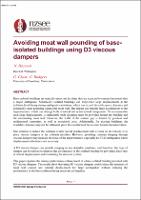Avoiding moat wall pounding of base-isolated buildings using D3 viscous dampers

Download
Date
2023-04-19Authors
Hazaveh, Nikoo
Chase, Geoffrey
Rodgers, Geoff
Metadata
Show full item recordAbstract
Base-isolated buildings are typically important facilities expected to remain functional after a major earthquake. Seismically isolated buildings can experience large displacements at the isolation level during strong earthquake excitations, exceeding the rattle space clearance and potentially pounding against the moat wall. The impact transfers large accelerations to the superstructure, which can damage structural and nonstructural components.
To accommodate such large displacements, a sufficiently wide clearance must be provided around the building and the surrounding moat wall. The width of the seismic gap is limited because of practical and architectural constraints and associated costs. Also, for existing buildings, the clearance available may not be sufficient given the evolution of the seismic hazard characterization.
One solution to reduce the isolation system lateral displacement with a focus on its velocity is to place viscous dampers at the isolation interface. However, it may be causing the increasing force of a superstructure by providing constant damping, such as ULS earthquakes that no need to reduce the displacement.
A D3 viscous damper can provide damping in any desirable quadrants. Therefore, this type of damper can be tailored to improve the performance of the isolated building by providing force just in critical displacement while recentering the isolation system.
This paper explores the seismic performance enhancement of a base-isolated building provided with D3 viscous dampers. The results show that using D3 viscous dampers could reduce the moatwall contact instances and reduce the residual displacement for large earthquakes without reducing the performance of the base isolation during moderate earthquakes.
